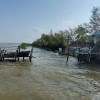Protecting Sundarbans: How Serious Are We?
One year ago this day (December 9), an oil tanker, OT Southern Star 7, carrying 357,000 litres of furnace oil collided with another tanker MT Total and sank in the Shela River in the Sundarbans. It sent a chill down the spines of not only Bangladeshis, but also the people of the entire world who care about natural forests and biodiversity. There was no significant action for the first three days. Consequent media coverage prompted the government to take more serious actions. From the fourth day, the owner of the oil shipment, Padma Oil Company, a state owned company declared that it would buy back the oil that spread over the river. Thereafter, the villagers of Joymoni, an adjacent village near Chandpai range office in the Sundarbans jumped into action and with their bare hands and household utensils, collected around 60,000 litres of furnace oil, easing the situation a little.
A year after the chilling event, how safe are the Sundarbans? This writer travelled to a dozen or so rivers and canals in the south, east and west wildlife sanctuaries of the Sundarbans in the last four months, spoke to hundreds of villagers and traditional resource users living around the forest and many forest officials to find the answer.
NAVIGATION THROUGH THE SUNDARBANS
Shipping through the Shela River in the Sundarbans started due to the siltation and loss of navigability of the Mongla-Ghoshialkhali channel that connects the Mongla port to the rest of the country. Of course the Pashur River itself, on which the Mongla port is situated, also goes through the Sundarbans. And there are other rivers like Arpangasia in Satkhira which big ships ply on under the auspices of Indo-Bangladesh water transit protocol. This always puts the forest in danger because of the noise of engines, leakage of oil and other pollutants from the ships, littering by sailors - not to mention spillage from a sunken ship. In last one and half year alone, at least seven vessels carrying oil, fertiliser, coal and fly-ash capsized inside the forest. When this article was being written, a cargo vessel full of coal was underwater in Pashur River off the huge 250-feet high Silo in Joymoni for more than a month waiting to be rescued, while another vessel carrying fly-ash was being rescued.
LAND USE NEAR THE SUNDARBANS
The proposed Rampal coal-based power plant, located just 4 km away from the Sundarbans Ecologically Critical Area (ECA), is feared by environmentalists to become a big threat to the bio diversity of the Sundarbans and agro-diversity in adjacent areas. On top of that, people are wilfully selling their lands to industrialists for inflated prices. In the near future, almost one hundred industrial installations are going to be built from Digraj to Joymoni along the 28 km stretch of the Pashur River. The land is being developed with the sand from Pashur. In many cases, the job is done free of cost as the Mongla port authority, who undertakes the dredging, needs a place to put that sand. In recent months, the dredging of the Mongla-Ghoshiakhali channel has facilitated such developments in the eastern part of Rampal as well. The Mongla EPZ is already located beside the channel, and there will be new industrial plots there soon. So in the near future, many of these factories will discharge their wastes into the channel and the Pashur River, which will be carried to the forest by tides. According to a latest document by the Department of Environment, 149 installations already pose threats to the Sundarbans (New Age, December 1, 2015).
RESTRICTIONS ON USE OF TRADITIONAL RESOURCES
While industrial activities are on the rise around the Sundarbans, the forest department is imposing more restrictions on traditional resource users like fishermen and others who collect honey, Nypa-palm leaves, etc. From the middle of this year, no engine boats are allowed to enter the forest for fishing purpose. This measure was taken to prevent poachers from escaping the site in haste. Many fishing boat owners removed the engines from their boats and continue fishing, thereby obviously damaging the productivity. Others started to go to other places outside the forest for the same purpose. Many fishermen have expressed concern about the impending loss of livelihood. If this continues, it is feared that many of these fishers might turn into poachers and robbers.
EQUIPPING FORESTERS AGAINST ROBBERS AND POACHERS
When closing the Sundarbans for traditional resource users, forest department show cause that if they are barred from the forest, there will be no robbing or kidnapping, and hunting and poaching will stop since it is evident that armed robbers are mainly responsible for these crimes. While robbers are the real concern for the forest department, it often leaves foresters with no means to fight the threat. Puspakathi is a remote forest patrol station located near the Bay of Bengal about 60 km south of Shyamnagar, Satkhira. There is no mobile phone network, and there are only four forest guards in this station. They have no guns, as robbers can attack them and take away their guns. The wireless device has been out of order for a long time. Seeking anonymity, a forest guard told us that the robbers often spend the night at the camp quarters!
Even the forest guards with guns are often helpless. A guard from Chandpai range told us a story about the time another guard pulled the trigger six times, but none of the rounds actually fired. Our guard himself was equipped with an Indian built semi-automatic rifle that was actually used during the War of Liberation in 1971. We entered a narrow canal near the Patkoshta station when we heard the chopping sound from ahead. The guards told the boatman to reverse the course, so we could avoid facing an armed group of possible robbers or loggers! Forest offices are not even supplied with necessary fuel; the officials are told to "manage" the fuel. No wonder that the forest officials "manage" the money through illicit means.
With the Royal Bengal Tigers' number dwindling to a mere 106, it is clear that the government needs to remain vigilant over Sundarbans. Increasing the capacity of the forest department and engaging the people living around the forest is very important. Restricting traditional resource collectors' access to the forest may become counterproductive. A wrong policy can lead to the extinction of the most gorgeous animal left in the land. Not to mention, without the tiger, there will be no Sundarbans!
The writer is a Research Associate with Society for Environment and Human Development (SEHD).
Email:[email protected]

 For all latest news, follow The Daily Star's Google News channel.
For all latest news, follow The Daily Star's Google News channel. 








Comments